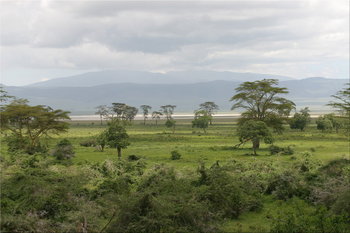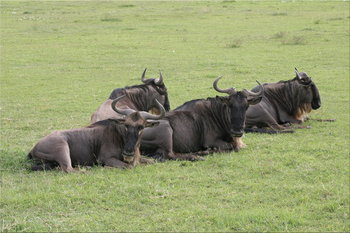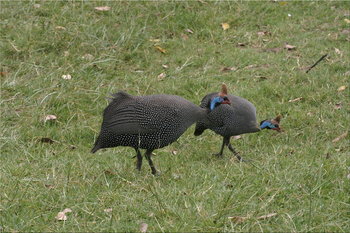
While the breakfast stuff is cleared away, I use the spare time I have to take a shower. I correctly assume that there will not be showers at the next two nights' campouts. Andrew, Pu, Vinh and I are in the land rover driven by Robinson, and we go ahead. In the town that the campground is in, the highway has, at perhaps 100m intervals, three sharp speed bumps, then a big one, then a crosswalk, then another big one and three sharp ones again. Robinson crosses these at 10km/h at most. This is the norm in every small town on the highways around here. I guess the cops don't have to bother much with speed limit enforcement.
Past the park, we go up the steep escarpment. Many people are seen pushing their single-speed bicycles up the hill. Seeing the curvy road with its perfect pavement, Andrew remarks that he could have some fun with his S2000 here. After a scenery stop at the top of the climb, we continue into higher ground around 5000 feet elevation. It is very fertile here. The reddish soil, the rolling hills and the active agriculture make the landscape very pretty. Even when there is a mix of pasture and crops, there are no fences anywhere, because each flock of animals is always watched by someone.
We stop for fuel in the town of Karatu. The price of Ksh 900 per litre of diesel is written on the pump housing in crayon; the actual tallying mechanism does not work. While we get fuel, an alarmingly pretty girl is trying to sell us handmade baskets. It is hard to watch her and not smile back, but of course doing so implies that you want to buy something. On the way through town, we note that there is an internet cafe here.
In the distance, high ground crowned by clouds is the rim of Ngorongoro Crater. The perfect road continues right up to the entrance station to the conservation area, where there is a construction zone and then only dirt road. At the entrance station, we go into the visitor centre and examine relief models of the crater while Robinson does paperwork. The other vehicle, driven by Issa and containing Peter, Caroline, Caroline, Yi and David the cook, catches up to us here. I watch some baboons but they are shy and disappear into the bushes if I get closer than 10m.
Formalities completed, we continue steeply uphill for quite some time, until the crater rim at about 8000 feet elevation, where we stop at a scenic overlook.

|
|
Ngorongoro Crater
|
We have to go along the rim for quite a distance before we reach the Simba campsite where we will spend the night. While the bags are unloaded and the trailer is unhitched, we watch some large Marabou storks. Then the safari roofs are opened up, and we continue around the crater rim to the descent road, where there is a steel gate and an armed ranger post and our paperwork is checked. I later see that at least one species of animal made nearly extinct by poachers (the white rhino) can roam in peace in this crater, perhaps because it is easy to keep the poachers out. The only way in and out is on the descent and ascent roads, respectively.
The descent road is bumpy and only one lane wide. There are fresh imprints of bulldozer treads where a landslide was cleared away. The bulldozer is parked by the road, down in the crater. We pass a Masai herdsman and his cattle. We are told that the Masai freely roam these conservation areas and don't interfere with the wild animals, and the lions don't interfere with their cows (having learned that the sharp end of a spear awaits them if they try anything - but at least the Masai teenagers don't hunt lions as part of their manhood rites any more).
On the crater floor, the first stop is the yellow acacia woods, where the elephants hang out. The woods have a slightly shopworn look to them for this reason, but are very beautiful nonetheless. We stop right by a very large bull elephant who ignores us.
 |
 |
| Elephant spotting | Very pretty elephant habitat |
We make many stops to marvel at the animals seen in the following pictures.
 |
 |
| Thomson's Gazelle | Grant's Gazelle |
 |
 |
| Mature bull elephant | White rhinoceros |
 |
 |
| Zebra | Wildebeest (aka Gnu) |
 |
 |
| Marabou stork | East African Crowned Crane |
 |
 |
| Guinea fowl | Baglafetch Weaver |
 |
 |
| Rufous-tailed Weaver | Superb Starling |
Driving around again after lunch, we spy some giant "Eland" antelopes in the distance. Note the size compared to the zebras in the foreground!
 |
 |
| Full-grown eland antelope | Hartebeest |
 |
 |
| Two lion cubs | Two more lion cubs |
 |
 |
| Hello kitty! | This cat is not concerned about much. |

|
|
Adult lion couple
|
Another reminder that these are only the best of hundreds of animal pictures on file here. Follow the "All pictures" link at the bottom of the page to see the rest of them. Also, the originals are 6 megapixel images suitable for printing up to 18x12" size. If you want one, let me know what for.
 |
 |
| Wart hog | Water buffalo |
 |
 |
| Ostrich (female) | Jackal (photo by Andrew) |
After hours of driving around, we are all happily content with the day's animal watching, and the safari vehicles all converge on the ascent road as the park gates will close soon. We stop for another brief look down into the crater.

|
|
Last look into Ngorongoro Crater from the ascent road
|
Then it is back to Simba campsite, which is the prettiest campground I've ever stayed in. A huge tree overshadows the meadow where tents are pitched, and you can see down into the crater. After dinner, we head to our tents in the dark, and I hear a munching noise and follow it. In the faint light of my headlamp, I see a huge bull bovine stop munching and stare back at me. Now, bull bovines are not known for their gentle tempers, and buffalo particularly not so, so I give up my investigation and prepare to go into my tent. Just then, Pu arrives, very agitated: "There's a big animal eating my tent! Pu had pitched his tent far from everyone else's for nighttime peace. Now what. We go into the cookhouse, and eventually come back with an armed ranger, our driver Robinson, and another guy. When they see what the trouble is, they have a good laugh. Apparently these particular buffaloes graze here all the time and never bother anyone. But Pu moves his (uneaten) tent to be with everyone else. In the night, I hear the buffaloes munching away between the tents anyway.
At this elevation, the climate is very nice and we sleep well.